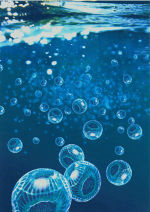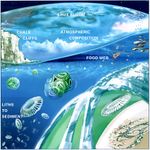Emiliana

Classification
Higher order taxa:
Eukaryota; Haptophyceae; Isochrysidales
Species:
Emiliania huxleyi, E. sp.
Description and Significance
Emiliania is a small organism that is famous for turning huge portions of the ocean bright turquoise during its blooms. They are also known for contributing to the white cliffs of Dover because of the calcite in their coccolith cell structure. They play a very important role in the carbon cycle in the ocean because they form calcium carbonate exoskeletons that sink to the bottom of the ocean floor when they die. They are also one of the worlds major calcite producers.
Genome Structure
Emiliania huxleyi was the first haptophyte organellar genome sequence to be published. The genome sequence showed the presence of a dam gene, which codes DNA adenine methyltransferase. This is common in bacterial genomes, but has not been shown in any studied mitochondrial genome. The mitochondrial sequencing revealed that Emiliania huxleyi has 29013 base pairs.
Cell Structure and Metabolism
Emiliania are coccolithophores, which means that they produce a shell like exoskeleton containing plates called coccoliths. The coccoliths are formed inside of the cell in the coccolith vesicle through a process called coccolithogenesis. When each coccolith is fully formed, it is transferred to the outside of the cell and the vesicle membranes fuse with the cell membranes and the external parts of the membrane are reabsorbed so that the coccolith is outside of the cell. When the cell dies, the plates separate and sink to the floor of the ocean, where they collect.
Very little is known about the complex life cycle of Emiliania. But it is known that there are three types of cells involved in the life cycle of a coccolithophore, non-motile coccolith-bearing cells (c-cells), naked non-motile cells (n-cells), and motile scale-bearing swarmers (s-cells). It is thought that the s-cells do have a sexual stage where they act as gametes, though it has never been observed. But the s-cells can reproduce vegetatively.
Emiliania, like most other phytoplankton, are autotrophic. They produce their own energy through oxygenic photosynthesis. Their photosynthetic organells are chloroplasts derived through "secondary endosymbiosis," that is, ancestral engulfment of an alga that already contained a chloroplast derived from a cyanobacterial ancestor.
Ecology


Emiliania is a marine coccolithophore that lives in cooler waters at depths of about 10-20 meters. This suggests that strong light intensities may be a factor in causing blooms to form. Blooms may also form because of low phosphate and iron levels. Emiliania generally prefers cold water, but can tolerate waters that are a little on the warm side as well. It also prefers is the water is nutrient poor, especially low CO2 concentrations, which helps with the process of calcification. They also are able to utilize dissolved organic phosphates better than most other phytoplankton.
They are a food source for certain bacteria and zooplankton, who feed on them during blooms. During these blooms they can be up to 90% of the phytoplankton in the bloom area, and the blooms can get to be 100,000 sq. kilometers, or about the size of England. These large blooms play a huge role in the earths atmosphere. The coccoltihs, rather than absorb light, reflect it which is what causes the turquoise color in the water. For a typical ocean, the proportion of photons re-emitted by the water increases from 1% when there are no coccoliths in the water, to 3% with 100 mg CaCO3/cm3 of coccoliths in the water, to 7% with 300 mg CaCO3/cm3 of coccoliths. This change in the Earth's albedo can have distinct affects on the climate. The blooms can also have an affect on the climate when it decomposes. All of the carbon that they drew out of the water, to make their coccoliths, now sinks to the bottom of the ocean, meaning that the atmosphere and the top of the ocean are no longer in equilibrium with the other CO2 levels. This draws the CO2 out of the atmosphere and into the ocean. This helps lower the amount of CO2 in the atmosphere that cause the greenhouse affect.
References
University of California. Earth Guide Coccolithophore - Emiliania huxleyi.
National Oceanography Centre, Southhampton. Emiliania huxleyi Home Page.
Young, Jeremy R. Emiliania huxleyi and other coccolithophore. Portal to Protistology.

